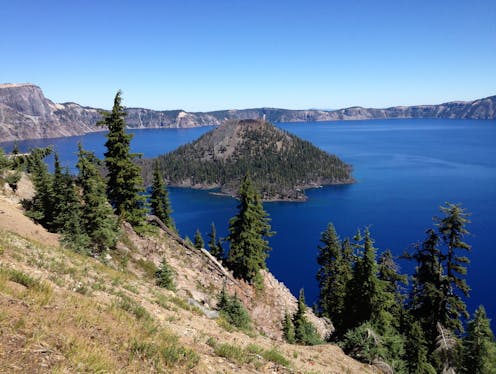Why is water different colors in different places?
- Written by Courtney Di Vittorio, Assistant Professor of Engineering, Wake Forest University

Depending on the properties of the particles in our water sample, they will absorb and scatter radiation at different wavelengths. The light’s wavelength determines the color we see with our eyes.
Waters that contain lots of sediment – such as the Missouri River, nicknamed the “Big Muddy[6]” – backscatter light across the yellow to red range. This makes the water appear orange and muddy[7].
Cleaner, more pure water backscatters light in the blue range, which makes it look blue. One famous example is Crater Lake in Oregon[8], which lies in a volcanic crater and is fed by rain and snow, without any streams to carry sediment into it.
Deep waters like Crater Lake look dark blue, but shallow waters that are very clear, such as those around many Caribbean islands, can appear light blue or turquoise[9]. This happens because light reflects off the white, sandy bottom.
When water contains a lot of plant material, chlorophyll – a pigment plants make in their leaves – will absorb blue light and backscatter green light. This often happens in areas that contain a lot of runoff from highly developed areas, such as Lake Okeechobee in Florida[10]. The runoff contains fertilizer from farms and lawns, which is made of nutrients that cause plant growth in the water[11].
Finally, some water contains a lot of material called color-dissolved organic matter[12] – often from decomposing organisms and plants, and also human or animal waste. This can happen in forested areas with lots of animal life, or in heavily populated areas that release wastewater into streams and rivers. This material mostly absorbs radiation and backscatters very little light across the spectrum, so it makes the water look very dark.
Bad blooms
Scientists expect water in nature to contains sediments, chlorophyll and organic matter. These substances help to sustain all living organisms in the water, from tiny microbes to fish that we eat. But too much of a good thing can become a problem.
For example, when water contains a lot of nutrients and heats up on bright sunny days, plant growth in the water can get out of control[13]. Sometimes it causes harmful algal blooms[14] – plumes of toxic algae that can make people very sick if they swim in the water or eat fish that came from it.
When water bodies become so polluted that they threaten fish and plants, or humans who drink the water, state and federal laws require governments to clean them up[15]. The color of water can help guide these efforts.
Engineering professor Courtney Di Vittorio and her students collect water samples from High Rock Lake in North Carolina to assess its water quality.My students and I collect water samples at High Rock Lake[16], a popular spot for swimming, boating and fishing in central North Carolina. Because of high chlorophyll levels, algal blooms are occurring there more often. Residents and visitors are worried that these blooms will become harmful.
Using satellite photos of the lake and our sampling data, we can produce water quality maps[17]. State officials use the maps to track chlorophyll levels and see how they change in space and time. This information can help them warn the public when there are algal blooms and develop new rules to make the water cleaner.
Hello, curious kids! Do you have a question you’d like an expert to answer? Ask an adult to send your question to CuriousKidsUS@theconversation.com[18]. Please tell us your name, age and the city where you live.
And since curiosity has no age limit – adults, let us know what you’re wondering, too. We won’t be able to answer every question, but we will do our best.
References
- ^ Curious Kids (theconversation.com)
- ^ curiouskidsus@theconversation.com (theconversation.com)
- ^ an engineer who studies water resources (divittorio.engineering.wfu.edu)
- ^ becomes runoff (www.usgs.gov)
- ^ Ali Damouh/Science Photo Library, via Getty Images (www.gettyimages.com)
- ^ Missouri River, nicknamed the “Big Muddy (missouririverwatertrail.org)
- ^ orange and muddy (www.yahoo.com)
- ^ Crater Lake in Oregon (www.nps.gov)
- ^ light blue or turquoise (www.whoi.edu)
- ^ Lake Okeechobee in Florida (www.fau.edu)
- ^ cause plant growth in the water (www.des.nh.gov)
- ^ color-dissolved organic matter (water.rs.umn.edu)
- ^ can get out of control (oceanservice.noaa.gov)
- ^ harmful algal blooms (oceanservice.noaa.gov)
- ^ require governments to clean them up (www.epa.gov)
- ^ High Rock Lake (www.highrocklakelife.com)
- ^ water quality maps (ee-cdivittorio-wfu.projects.earthengine.app)
- ^ CuriousKidsUS@theconversation.com (theconversation.com)
Authors: Courtney Di Vittorio, Assistant Professor of Engineering, Wake Forest University
Read more https://theconversation.com/why-is-water-different-colors-in-different-places-243895

